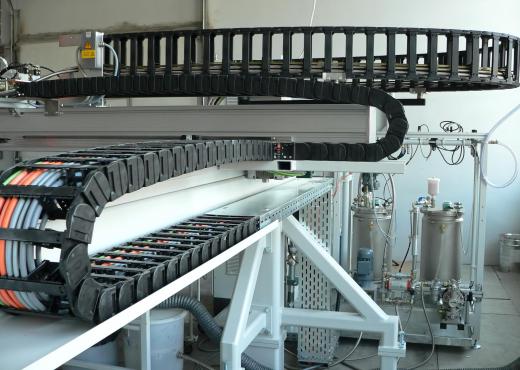At AboutMechanics, we're committed to delivering accurate, trustworthy information. Our expert-authored content is rigorously fact-checked and sourced from credible authorities. Discover how we uphold the highest standards in providing you with reliable knowledge.
What is an Apron Feeder?
An apron feeder is a large machine that carries materials through the parts of a manufacturing or industrial process. These machines resemble short conveyor belts, and may also be known as plate feeders or apron conveyors. Apron feeder machines allow engineers and process managers to automatically control the volume of materials that are added to a process, and regulate the rate at which these materials are added.
Manufacturers construct apron feeders from heavy, durable materials like steel. The machine must be capable of supporting large, bulky materials like rocks, which may have jagged edges. To withstand the heavy weight of these types of materials, the belt portion of the apron feeder is made from thick steel trays or pans. Chains along either end of the feeder help move the trays along the conveyor area, and are powered by an industrial motor or engine.

Apron feeder machines can be found in mining operations, factories, and concrete plants. In mining, the apron feeder carries rocks and minerals for crushing or further processing. At a factory, these machines may be used to add ingredients to a food or other mixture. Because of their heavy-duty design, apron conveyors are also a popular choice for transporting concrete and stone for crushing, recycling, or mixing.

Materials that will be carried by the apron feeder are held in a large hopper above one end of the belt. The amount of material that reaches the feeder is determined by the distance between this hopper and the top of the feeder. If the two are placed close together, only a small volume of materials can reach the belt at any given time. When the hopper is placed farther away, materials pour onto the belt more quickly to speed up the feeding process.
As the hopper deposits materials onto the apron feeder, the metal pans that make up the belt travel horizontally like a conveyor belt. When the trays reach the end of the belt, they dump, or feed the materials into another vessel. This may be a large bin, sorting machine, grinder, or any other vessel needed to complete the specified process. Workers can adjust the speed of the belt to speed up or slow down the manufacturing process as needed. Workers also can stop the belt to pause feeding and makes any required changes.
Apron feeding machines cannot be used in applications where precise feeding and measuring is required. For example, they cannot be used to mix sensitive ingredients at an exact ratio to make food, medicine, or cosmetics. They are also not designed to hold most liquids, and require modification before they can transport fluids effectively.
AS FEATURED ON:
AS FEATURED ON:












Discussion Comments
A big thanks to whoever took the time to post stuff abut apron feeders!
Post your comments